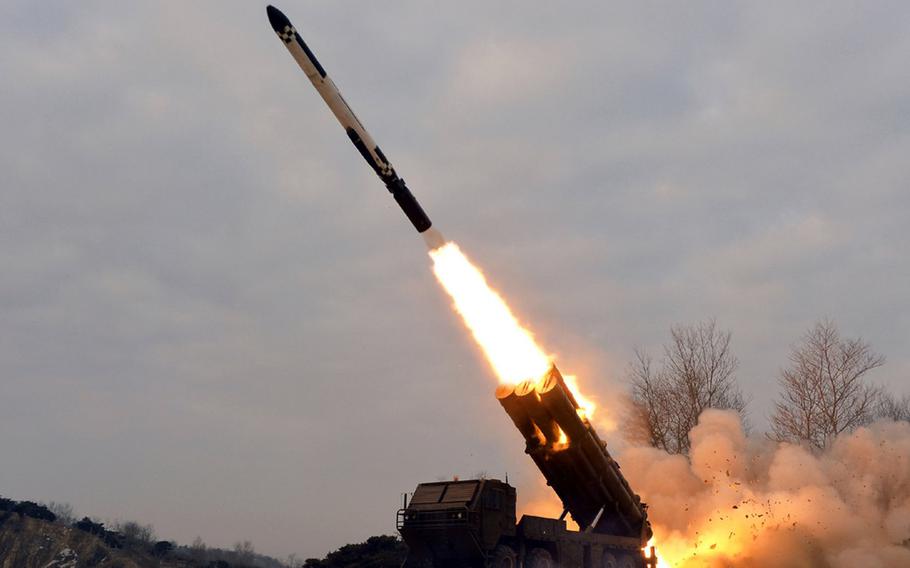North Korea launched more than ten missiles, including one that landed near South Korean waters, which President Yoon Suk-yeol described as an “effective territorial invasion.”
Ulleungdo received an air raid warning, which was broadcast on national television, and residents were advised to “evacuate to the nearest underground shelter.”
South Korea also closed some air routes over the East Sea, also known as the Sea of Japan, and advised local airlines to detour in order to “ensure passenger safety on routes to the United States and Japan.”
One short-range ballistic missile crossed the Northern Limit Line, the two countries’ de facto maritime border, prompting a rare warning for residents on the island of Ulleungdo to seek shelter in bunkers.
According to the military, it was the “first time since the peninsula was divided” at the end of Korean War hostilities in 1953 that a North Korean missile had landed so close to South Korean territorial waters.
“(Yoon) pointed out today that North Korea’s provocation is an effective territorial invasion by a missile that crossed the Northern Limit Line for the first time since the division,” according to a statement from his office.
According to the military, the missile that was closest to South Korea landed in waters just 57 kilometres (35 miles) east of the South Korean mainland.
The military issued a statement calling the missile launch near South Korean territory “very rare and intolerable.”
“Our military vowed to respond firmly to this (provocation),” it added.
The Joint Chiefs of Staff of the South Korean military initially stated that three short-range ballistic missiles had been launched.
However, it was later revealed that North Korea had launched “at least 10 missiles of various types today towards the east and west.”
Yoon Suk-yeol convened the National Security Council in response to the launches, ordering “swift and stern measures so that North Korea’s provocations pay a clear price.”
Japan also confirmed North Korean missile launches, with Prime Minister Fumio Kishida telling reporters that a “national security meeting” would be convened as soon as possible.
Vigilant Storm
Pyongyang’s latest launch coincides with the largest-ever joint air drills between Seoul and Washington, dubbed “Vigilant Storm,” which involve hundreds of warplanes from both sides.
According to a report in state media Wednesday, Pak Jong Chon, a high-ranking official in North Korea, said the drills were aggressive and provocative.
The name of the exercises, according to Pak, is a reference to Operation Desert Storm, the US-led military assault on Iraq in 1990-1991 after it invaded Kuwait.
“If the US and South Korea attempt to use armed forces against the (Democratic People’s Republic of Korea) without any fear, the special means of the DPRK’s armed forces will carry out their strategic mission without delay,” he said.
“The US and South Korea will have to face a terrible case and pay the most horrible price in history.”
Close to S Korea
According to the military, one of the missiles landed in waters just 57 kilometres (35 miles) east of the South Korean mainland on Wednesday.
“In protest of the joint US-South Korea drill, Pyongyang seems to have staged the most aggressive and threatening armed demonstration against the South since 2010,” Cheong Seong-chang, a researcher at the Sejong Institute, told AFP.
A North Korean submarine torpedoed the South Korean naval vessel Cheonan in March 2010, killing 46 sailors, including 16 on mandatory military service.
The North shelled a South Korean border island in November of the same year, killing two marines, both of whom were young conscripts.
“It is now a dangerous and unstable situation that could lead to armed conflicts,” he added.
The test comes after a recent barrage of launches, including what the North claimed were tactical nuke drills, that Washington and Seoul have repeatedly warned could lead to another nuclear test, Pyongyang’s seventh.
The air drills, known as Vigilant Storm, were preceded by a 12-day amphibious naval exercise.
“As far as I can remember, North Korea has never made such a provocation when South Korea and the US were holding their joint drills,” Park Won-gon, an Ewha University professor, told AFP.
“Pyongyang seems to have completed its most powerful deterrent. This is a serious threat. The North also seems confident in their nuclear capabilities.”

